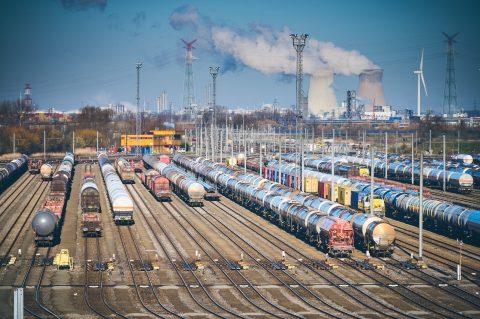Belgium approves plan to double rail freight transport by 2030
The action plan in Belgium to double the volume of rail freight transport by 2030 has been approved by the government. On Friday 30 September, the Council of Ministers approved the plan that was proposed a year ago. 26 concrete actions are now on the table to make “the backbone of tomorrow’s mobility” in Belgium.
The Rail Roadmap was presented by more than twenty organisations in September 2021. It is not entirely clear why it took a year for the plan to be approved, but according to the Brussels Times, the Federal Government is “seeking to capture the benefits of the recent surge in the value of imports and exports (pushed by the war in Ukraine).”
“The Freight Transport Plan that the government approved (today) is the result of constructive discussions with the economic world and especially with the logistics players. We now have a precise roadmap to achieve our ambitious target of doubling rail freight by 2030″, said minister Gilkinet on the occasion.

The action plan
In concrete terms, investments will be made in the critical nodes of the network so that all bottlenecks will be eliminated by the end of 2027. The rail network will also be equipped for longer trains, up to 740 meters in length, to increase the competitiveness of rail. And, there will be better harmonisation of the available train paths. This will be a (new) responsibility of infrastructure manager Infrabel.
At the same time, Belgium will make an effort to remove the barriers to cross-border transport: “We will take action at European level to try to remove a number of provisions that hinder international rail freight transport, such as the lack of a single language for the European rail freight transport. Until now, train drivers still have to master the language of all the countries in which they operate”, continues Gilkinet.
No mention of investments
The minister did not mention the investments these measures require. The same was true last year, when it was made clear by the parties that money was needed for the realisation of the plans. They looked at the government for funding.
“From a budgetary point of view, we mainly rely on Infrabel’s proposal for a multi-year investment plan, which we already know will be insufficient for the realisation of the infrastructure needs of this plan”, commented the Belgian Rail Freight Forum. “There are no new concrete operational and innovation support budgets yet.”
Missing links
The same industry group also pointed out some missing elements of the plan of action. Major project proposals, such as 3RX, the additional Antwerp North connection and the Antwerp-Zeebrugge freight line are not included. “This threatens to preclude decisive action in the future.”
However there is a sign of political commitment, it positively notes. “There is now a political framework in which work can be done in the coming decade for more rail transport as the most climate-friendly and environmentally friendly mode of transport.”
This article was originally published on RailTech.com the organiser of RailTech Belgium.
morenews
First edition of RailTech Belgium opens registration
The first speakers of the conference are confirmed, among which Georges Gilkinet, Deputy Prime Minister and Minister of Mobility in Belgium, Michel Ruesen, Managing Director of the ERTMS Users Group and Thierry Vanelslander, professor at the Department of Transport and Regional Economics of the University of Antwerp. The conference topics The morning conference will look… Read more ›
Infrabel completes 12-year upgrade project of Belgian port shunting yard
The Zwankendamme bundle has ten electrified tracks, four of which are long tracks. In addition to these tracks, there is a separate bundle of 4 tracks where Infrabel customers can temporarily park their locomotives. In the past, locomotives were parked in the shunting yard, which resulted in a loss of capacity. The new infrastructure also… Read more ›
Major improvements for Brussels’ public transport infrastructure planned for 2023
The work will require 3,150 metres of track beams, 134 prefabricated track modules and more than 400 intermediate precast slabs, as well as 5,000 square metres of bricks embedded in those modules, almost 1,900 metres of drainage trenches, more than 7,500 concrete sleepers and as many thousands of accessories for fixing and protecting the tracks…. Read more ›
